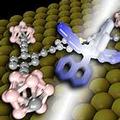 以單一分子所製成的車子發動了!而身體動作所產生的機械能可用來發電,甚至是供應植入性醫療器材所需的動力──這些還只是在過去一週來所公佈的兩項突破性奈米技術;所有技術皆以奈米單位為基礎,即十億分之一米的尺寸,大約是人類頭髮直徑的萬分之一。
以單一分子所製成的車子發動了!而身體動作所產生的機械能可用來發電,甚至是供應植入性醫療器材所需的動力──這些還只是在過去一週來所公佈的兩項突破性奈米技術;所有技術皆以奈米單位為基礎,即十億分之一米的尺寸,大約是人類頭髮直徑的萬分之一。
科學家發表的奈米車約3-4奈米,大概跟DNA的一股同寬,但比DNA短得多。大約2萬台這種奈米車一輛接一輛停好,可將人類的一根頭髮圍住。它們是第一輛內有引擎的奈米級車子。
另一個不同以往的奈米技術也在本週問世。這個技術由喬治亞理工學院所提出,將身體的移動、肌肉的張力或水流的機械能轉換成電能。這些「奈米產能器」可植入醫學裝置、感應器及攜帶式電子儀器中。
「在我們的環境中有許多可利用的機械能,」喬治亞理工學院物質科學及機械系教授王章林(音譯)說,「我們的奈米發電器可以將機械能轉換成電能,這讓未來的奈米科技開啟更多的可能性。」
加州大學柏克萊分校的研究人員發現一個直接、連續且可控制的方法,利用電場來製造奈米纖維。這個新的技術被稱作「近場放電紡絲」(near-field electrospinning)。此法製造出的奈米纖維是一種新的,具有規則紋理的專門素材,可應用在傷口敷料、過濾材料及生物支架。
雖然奈米材料十分有用且吸引人,但美國環境保護署說它們或許會危害人類健康及環境。
「這個新興的領域有潛力使環境保護轉型。研究人員現在正測試一種可清除大面積地下水污染物的離子奈米微粒,這個方法比現有的任何技術來得便宜有效,」環保署研發部助理局長葛雷說。
「在同時,我們必須了解奈米微粒是否對健康或環境造成衝擊,」葛雷說,「這個研究將有助於決定奈米科技是否適合成為環境保護的一個工具。」
人類健康研究方面正進行奈米微粒在皮膚上的吸收及毒性測試,以及對飲用水和肺部組織的影響。而環境研究學者正調查海水及淡水的沉積物及水生細菌、藻類、植物所受到的衝擊,以及奈米微粒吸收或釋放環境污染物的情況。
Cars made of a single molecule now are motorized, and mechanical energy from body movement is being harnessed to generate electricity and eventually, power implantable medical devices. These are just two of the nanotechnology breakthroughs announced in the past seven days. The advances are based on work with nanometers - each one billionth of a meter in size - about one ten-thousandth the diameter of a human hair.
The nanocars, which measure just 3-by-4 nanometers, are about the same width as a strand of DNA, but much shorter than DNA. About 20,000 of these nanocars could be parked, side-by-side, across the diameter of human hair. They are the first nanoscale vehicles with an internal motor.
A different nanotech advance has emerged this week from the Georgia Institute of Technology (GIT). By converting mechanical energy from body movement, muscle stretching or water flow into electricity, these "nanogenerators" could make possible a new class of self-powered implantable medical devices, sensors and portable electronics.
"There is a lot of mechanical energy available in our environment," said Zhong Lin Wang, a Regents Professor in the GIT School of Materials Science and Engineering. "Our nanogenerators can convert this mechanical energy to electrical energy. This could potentially open up a lot of possibilities for the future of nanotechnology."
Researchers at University of California-Berkeley, have found a way to use the electric-field process to make nanofibers in a direct, continuous and controllable manner. The new technique, known as near-field electrospinning, offers the possibility of producing out of nanofibers new, specialized materials with organized patterns that can be used for such applications as wound dressings, filtrations and bio-scaffolds.
Useful and intriguing as nanomaterials are, the U.S. Environmental Protection Agency says there may be dangers to human health and the environment.
"This emerging field has the potential to transform environmental protection. Researchers are now testing iron nanoparticles that could clean up pollutants in large areas of groundwater cheaper and more effectively than any existing techniques," said George Gray, assistant administrator for EPA's Office of Research and Development.
"At the same time, we must understand whether nanomaterials could negatively impact health or the environment," said Gray. "This research will help determine the viability of nanotechnology as a tool for protecting our environment."
Human health research underway is testing the absorption and toxicity of nanoparticles on skin, the effects of nanoparticles on drinking water, and the effects of nanoparticles on lung tissues. Environmental researchers are investigating the impacts on marine and freshwater sediments and on aquatic bacteria, algae and plankton; and the conditions under which nanoparticles absorb or release environmental contaminants.





